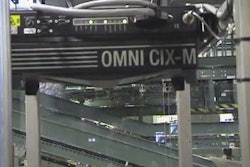Packaging departments have long considered the requirements of shipboard containers, says Ralph Drayer, longtime chief of logistics for Procter & Gamble Co., Cincinnati, OH, and now chairman of Supply Chain Insights. Shape and size of outer product packaging dictates pallet fit, for one thing, and arranging pallets neatly inside containers is important. So is keeping the packages from getting crushed once inside the container. So the stability of primary and secondary packaging has long been an ocean-shipping consideration.
But since 9/11, packagers have added security to their container concerns, especially with regard to ocean-arriving imports that are presumed vehicles for terrorists and their weapons of destruction. Packaging purists might not consider the electronic seals and locks that are the container imperative du jour an issue in their domain.
But the seals are to containers as bar codes are to primary packages, and the seals that Congress wants to see proliferate will eventually migrate from the container to the actual package itself.
Moving in same direction
Congress’s primary concern is national security, but ports, shipping companies and package shippers themselves seem anxious to jump-start the move toward container security for theft avoidance as much as for protection against Al-Qaeda. Regardless of the motives, the vehicle for the stimulus will be the conferenced version of already-passed House (HR 3983) and Senate (S 1214) maritime security bills.
A key provision in the House bill would obligate the Department of Transportation to develop performance standards “to enhance the physical security of shipping containers, including standards for seals and locks.” The Senate passed its bill without any specific reference to container security. Both bills would require ports to develop elaborate new security plans that would surely include closer tracking of containers and their contents.
Container identification technology, whose development was spurred by the Department of Defense (DOD) after the Gulf War, has yet to catch on in the private sector because of the lack of standards, a problem Congress will ostensibly solve via the House “seals” provision.
But even given the absence of standards, the maritime industry and its technology partners are already beginning to develop the port infrastructure to support greater commercial use of devices such as radio frequency identification (RFID) tags, which DOD already uses. All sorts of vendors offer these tags, which contain microchips, circuit boards, and tiny antenna. These components allow the tags to send and receive information, a heck of a lot more than any bar code can do.
Software, too
Savi Technology (Sunnyvale, Calif.), which helped DOD build its Total Asset Visibility (TAV) container tracking/security network, has developed sophisticated software around its hardware tags; both will be at the heart of a project called “Smart and Secure Tradelanes” (SST). Initially, this will involve the world’s three largest port operators — Hutchison-Whampoa Ltd., PSA Corporation Ltd., and P&O Ports, which together operate 70% of the world’s ports.
The real-time tracking and security network was expected to be operational by year-end, linking ports such as Singapore, Rotterdam, and Hong Kong with major U.S. ports such as Seattle/Tacoma, which will be the first domestic port to roll out the system. Mark Nelson, a Savi spokesman, says companies from the pharmaceutical, automobile, and high-technology industries will be among the first to test the new system that offers benefits for logistics as well as for security.
P&G alumnus Drayer, who recently joined the Savi advisory board, says a number of packaged goods manufacturers are supporting a project at the Massachusetts Institute of Technology that aims to adapt these RFID tags for use on grocery shelf packages. “Those tags are three to five years off in the future,” says Drayer. Such package tags will allow retailers to automate further by using stationary readers—which don’t have to be in the direct line of sight of the tag—to keep track of products instead of handheld bar code scanners.
Other devices
Not all container security devices are so high-tech. Companies such as CMG Security Solutions (Somerset, N.J.) sells a range of maritime shipping security products such as “navalocks” for the outside of the container and tamper-evident tape that goes on the packages inside the container.
Some of these were popular long before the World Trade Center attacks. The 10 million TEUs (Twenty-foot equivalent unit shipping containers) imported into the U.S. (based on 1999 numbers)—the equivalent of 5 million truckloads of goods—are a magnet for theft as much as a potential hiding place for interloping terrorists.
A number of federal agencies have estimated total annual loss due to cargo theft at about $10 billion a year. “Underwriters are increasingly unwilling to insure high-value cargo,” says Bruce Carlton, acting deputy U.S. maritime administrator. That concern, as much as anything, is leading manufacturers to even the lowest of low-tech theft solutions such as shrink-wrapping an entire shipboard container.
“Before 9/11, it was mostly the pharmaceutical companies that were worried about the safety of their shipping containers,” says Joel Shofel, a sales manager for CMG. “Now companies in many industries are becoming pro-active.”

























